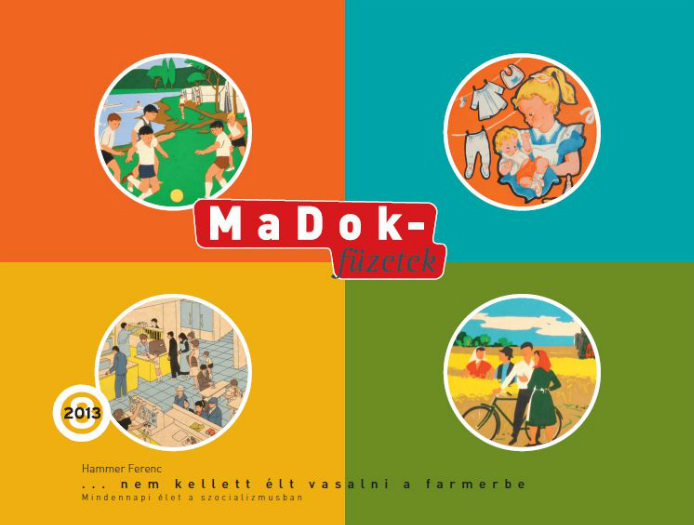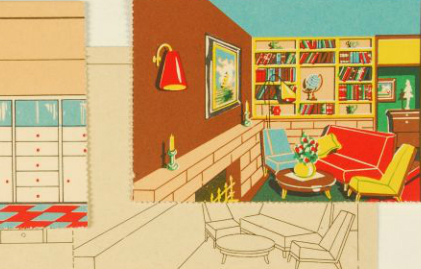Everyday Life Under Socialism
BOOK
Ferenc Hammer’s four studies play out in pre-democratic Hungary. Their key figures, though ordinary people like us, are younger and have a relationship to objects and ordinary days that is entirely different.
| Frazon Zsófia |
2013-09-04 15:00 |
For this, the eighth volume of the MaDok series, everything has changed a little. Take the matter of authorship: until now, every volume in the series has had multiple authors, each affiliated in some way with the museum scene. Here, by contrast, the work of a single sociologist is featured. Also for this volume, the definition of “contemporary” has been expanded: before, our view was restricted to the time following the fall of Hungary’s previous regime. Here, instead, we reach back further, but for what purpose?

In …Jeans Don’t Need Ironing: Everyday Life Under Socialism, sociologist Ferenc Hammer presents four studies on life in socialist Hungary, featuring objects, people, and places both familiar and unfamiliar. The topics are jeans, board games, truck drivers, and night life, respectively. The period under study is not the present that surrounds us now, but the recent past; its stories end where the “present,” as it has been understood in this series thus far, begins. Again, the question arises: why?
 When the MaDok program was launched in 2003, it was with the idea that a clear, practical, methodologically sound time boundary is worth drawing where the concept or project in question is based on – or derives meaning from – comparison with a particular time or chronology. Ten years ago, the fall of communism and rise of democratic rule seemed a practical boundary line: a limit of 1989 could be justified on the basis of the cultural and social changes that came with that date, and could be seen as helping the reader to understand the “present” not as an arbitrary concept, but as the actual here and now. The intent was to place focus squarely on the true present, to make it something larger than just the period at the end of the story. This approach was important from the standpoint of museum methodology, as it gave the reader the opportunity of taking two steps back from the topic, so as to view it an analytical eye.
When the MaDok program was launched in 2003, it was with the idea that a clear, practical, methodologically sound time boundary is worth drawing where the concept or project in question is based on – or derives meaning from – comparison with a particular time or chronology. Ten years ago, the fall of communism and rise of democratic rule seemed a practical boundary line: a limit of 1989 could be justified on the basis of the cultural and social changes that came with that date, and could be seen as helping the reader to understand the “present” not as an arbitrary concept, but as the actual here and now. The intent was to place focus squarely on the true present, to make it something larger than just the period at the end of the story. This approach was important from the standpoint of museum methodology, as it gave the reader the opportunity of taking two steps back from the topic, so as to view it an analytical eye.
As a methodological decision, however, the intent was not to rip people, objects, and terrain from their chronological context, with the thinking that these things do not have their own stories, that their forms and patterns do not change over time. To grasp the role played by a Chinese-made nylon shirt on the stage of modern consumer culture, for example, there is little need to examine the entire story from the early galalithite button to the textile industry revolution; it is enough to consider what Asian mass products mean in Hungary today, why consumers choose to buy cheap, unbranded products, how these objects are filled with stories in the course of everyday life, and in all this, where the museum comes in as an important medium for the study of objects. To understand how plastic became a household material during the 1970s, on the other hand, one cannot ignore the first half of the 20th century, World War II, the oil embargo, or the socialist East German and Soviet plastics industries.
 Ferenc Hammer’s four studies play out in pre-democratic Hungary. Their key figures, though ordinary people like us, are younger and have a relationship to objects and ordinary days that is entirely different. The reasons for this are both cultural and political. On the one hand, life then operated on an entirely different internal mechanism: the concepts of workplace, study, community, and leisure time all meant different things. At the same time, the apparatus of political control inhibited the free flow of not only goods, but also experiences. And of course, during this period, people already encountered numerous objects, individuals, and situations – jeans, board games like Monopoly, and even truck drivers – that reminded them of the borders that defined them, and the opportunities they perceived as lying beyond.
Ferenc Hammer’s four studies play out in pre-democratic Hungary. Their key figures, though ordinary people like us, are younger and have a relationship to objects and ordinary days that is entirely different. The reasons for this are both cultural and political. On the one hand, life then operated on an entirely different internal mechanism: the concepts of workplace, study, community, and leisure time all meant different things. At the same time, the apparatus of political control inhibited the free flow of not only goods, but also experiences. And of course, during this period, people already encountered numerous objects, individuals, and situations – jeans, board games like Monopoly, and even truck drivers – that reminded them of the borders that defined them, and the opportunities they perceived as lying beyond.
In these studies, somewhere beyond the broader connections, tiny details grow sharper: the freedom and longing represented by a pair of jeans, the supportive – or critical – attitude toward the politico-economic system shown by a board game, the near mythical status of the men who crossed borders in their trucks, and the cultural attitude that bred opportunities for free, critical thinking and artistic expression within the Kádár regime. The period that is studied here extends from the 1950s until the 1990s. Through professional literature, interviews, and personal experiences, the reader is taken into the realm of the social sciences, where the terrain is no longer that of the museum and its collections of artefacts, but where the culture of ordinary objects nonetheless serves as a showcase for work-a-day life, one that illuminates the object-centred world of ordinary days, leisure time, and the process of consumption.
Photo: Sarnyai Krisztina